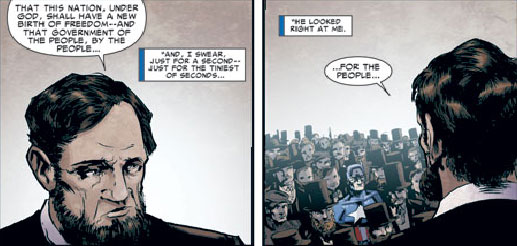Two-Fisted Emancipator
 I only wish Marvel had gone the full nine yards with its “Presidents’ Day Special†online issue of Spider-Man comics. The cover (left) with its brawny Lincoln getting ready to rumble (“to save Americaâ€) promised at least a moment of surrealism if not much clarity about the identity of Lincoln’s adversary (the reader having adopted the latter’s point of view). One might have hoped for, as the cover announces, some sort of alliance with Captain America who could personify (in his primary red-white-and-blueness) the Union as the duo clobbered the Confederacy. But Marvel’s embrace of history is disappointing—a comment that, yes, I know, borders on the risible. But bear with me a moment.
I only wish Marvel had gone the full nine yards with its “Presidents’ Day Special†online issue of Spider-Man comics. The cover (left) with its brawny Lincoln getting ready to rumble (“to save Americaâ€) promised at least a moment of surrealism if not much clarity about the identity of Lincoln’s adversary (the reader having adopted the latter’s point of view). One might have hoped for, as the cover announces, some sort of alliance with Captain America who could personify (in his primary red-white-and-blueness) the Union as the duo clobbered the Confederacy. But Marvel’s embrace of history is disappointing—a comment that, yes, I know, borders on the risible. But bear with me a moment.
I think it’s safe to surmise that this six-page tale is Marvel’s gesture to civics education. Sure, almost half of the pages of “Gettysburg Distress†is an inept set up for the Captain to reminisce about the time a “cosmic cube†thrust him back to the November 19, 1863 dedication ceremony, but after that the rest of the story encompasses Lincoln’s speech. It’s a rather dreary visual rendition of the event, lots of blank-faced, bearded men in dark suits and lots of close-ups of a curiously thick-necked Lincoln with a startlingly brief upper lip (I guess he left his dentures back in Washington). In short, it’s a rather flaccid effort to offer young readers some history while studiously avoiding any reference to slavery, the Confederacy, and secession.
The two-fisted Lincoln on the cover, spouting the address as he belted his way toward “a new birth of freedom†would have been an interesting and refreshingly bizarre alternative. But maybe I’m just not in tune with the spirit of this particular story, which, amid the civics lesson, offers a startling insight into the Marvel universe (one I thought I’d grasped long ago when I was a devoted reader and comics were ten cents). Marvel’s contribution to the super-hero genre was the introduction of characters who saw their powers as burdens, cutting them off from the rest of humanity. But in this tale, a Technicolor Captain America popping up amid the Gettysburg crowd doesn’t seem to provoke any comment or, for that matter, self-consciousness on the Captain’s part. Indeed, as Lincoln’s speech draws to a close . . .
It’s probably just an indication of how little effort went into writing this tale, but the normalization of the super hero seems to be in direct proportion to the strangeness of Lincoln.
By the way, if you’re looking for a truly surreal take on history, let me direct you to last Sunday’s installment of the comic strip “Gasoline Alley.â€
Last 5 posts by Josh Brown
- The Civil War Draft Riots at 150 – A Public Event - June 17th, 2013
- Alfred F. Young - November 7th, 2012



